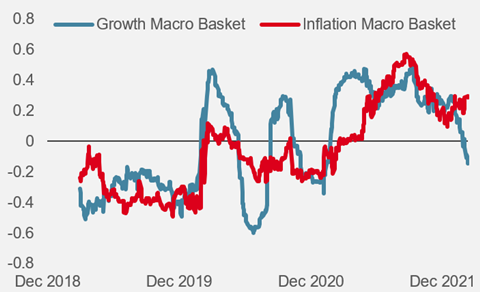Although fears of an inflationary spiral may seem justified, a deeper analysis suggests otherwise
Inflation has been the focus for investors, with the current surge caused by an exceptional convergence of COVID-related events, uneven policy mix and a “no inventory/just in time” supply chain.
US consumer prices surged by 7.9% year-on-year (YOY) in February with no apparent end in sight. To make matters worse, the Ukraine crisis propelled many commodity markets to record highs.
Although fears of an inflationary spiral may seem justified, a deeper analysis suggests otherwise. We believe inflation will peak sooner than expected.
Our view is based on the following factors:
1. Reversing supportive policy mix
The latest dot projections by the US Federal Reserve, were hawkish and showed:
- A larger deviation of Personal Consumption Expenditure inflation from its long-term target. The Fed forecasts inflation to end 2022 at 4.3% vs 2.6% last December – 2.3% higher than the long-term target (2%).
- Lower activity this year, with a sharp downgrade of its GDP forecast from 4% to 2.8%.
- Higher terminal rates, from 2.5% to 2.8%, above their long-term neutral rates (2.5%), meaning that it expects to implement a restrictive bias to curb inflation pressures.
These changes reflect the shift in the Fed’s target from “financial stability” and “growth support” to “inflation fighting”. This shift is clearly visible when we analyse the dispersion of dot projections for the two-year forward Fed Fund rates.
Indeed, the spread between the “dovish” and the “hawkish” camps narrowed sharply and looks tighter than in previous hiking cycles, reflecting the strong consensus among Fed members.
The minimum two-year Fed rate, reflecting the most cautious members, is now 2.4% against 3.3% for the maximum two-year Fed rate, representing the most hawkish members.
2. Easing in bottlenecks
The dynamic in producer prices is encouraging given they are decelerating in China. The correlation with US producer prices is historically very high and suggests a similar reversal in the coming months for the US, providing some flexibility for corporate pricing.
Moreover, as highlighted by the NY Fed indicators that track Global Supply Chain Pressures, bottlenecks are easing in 2022 with most of its sub-components decreasing in January and February – this is in line with our US Inflation Nowcaster and indicates a peak for US inflation.

3. Limited risk of an inflationary wage spiral
We think the major risk for the US economy and the path of Fed normalisation would be a continued rise in wage growth pushing inflation pressures higher and corporate profitability lower. To assess its magnitude, we employ various relationships connecting inflation, unemployment rates and wage growth.
Historically, Okun’s law implies that stronger activity leads to lower unemployment and higher inflation, while the Phillips curve suggests the lower the unemployment rate, the larger wage growth is. Plotting these three variables shows that current relationships don’t support the inflation/wages spiral narrative.
Firstly, the current Phillips curve appears flatter than the historical one, reflecting a lower wage growth sensitivity to changes in employment. Current wage growth at 5.8% is in line with past episodes of low unemployment rates.
Secondly, given the current level of inflation, wage growth would be much higher historically. In our view, wage growth would need to be above 7% YOY to lead to an inflation/wage spiral scenario. Given the decline in medium-term inflation expectations from households exhibited in the latest NY Fed survey, we doubt wage growth will reach this level.
4. Large base effects ahead, even with a higher geopolitical risk
the base effect for the US CPI (ex energy) will be large in the coming months. Our analysis of monthly changes in the US CPI indicates that the biggest surprise in realised inflation occurred in April, May, and June 2021. As a result, our analysis of the drivers of the surge in US inflation leads us to forecast a large deceleration that could happen soon.
… pushing real assets pricing at risk for H2 2022
With inflation at highs not seen since the 1980s, the Fed and economists expect a deceleration by the end of 2022. Although current forecasts show inflation durably above the Fed’s long-term 2% target, the expected deceleration in inflation would reduce macroeconomic data volatility and do less damage to the economy than in the 1970s, when inflation remained at record highs for many quarters.
Does this mean that inflation hedges have become expensive? In a nutshell, we believe that inflation risk is well priced in different assets and has become a crowded trade.
5. An already aggressive pricing of inflation risk
Looking at the current pricing embedded in various assets gives a good idea to what extent markets have repriced inflation risk. As reflected by the performance of Unigestion Macro Baskets that track the major macroeconomic risks, real assets have outperformed massively. This repricing is also visible in forward inflation swaps.
Regardless of tenor, maturity or country, breakevens are high and still rising along the short and long end of the curve. For example, the current US 10-year breakeven swap is at 3% vs an average of 2% between 1998 and 2020. However, the forward five-year inflation swap remains below its long term 2.7% average, at 2.5%, reflecting the Fed’s credibility when it comes to lowering inflation pressures medium term.
6. From over-owned to crowded
This repricing in the inflation premium also reveals investors’ repositioning in favour of real assets. This rotation manifests itself in the sector allocation for the Momentum equity factor.
The change in the non-sector neutral equity factor computed by our equity team exhibits a large shift from IT and discretionary to sectors positively correlated to inflation breakevens such as financials, real estate, and energy.
This repositioning is also visible through the correlation between the Momentum equity factor and Unigestion’s Macro Baskets.
As Figure 1 shows, the correlation with the Inflation Macro Basket turned positive during 2021 and will stay historically high in 2022. The recent period also shows a clear rotation from the “growth” to the “inflation” thematic.
This suggests equity markets are pricing in a more negative inflation narrative, driven by a supply shock rather than growth expansion.
Figure 1: Momentum Equity Factor and Macro Basket Correlation

Source: Unigestion, Bloomberg. Data as at 10.03.2022
These different elements reveal a highly concentrated positioning for much of the investment community favouring one thematic: high inflation for longer.
Having detected the rise in inflation risk very early in 2021 and adjusting our portfolios accordingly, we know how to protect against a major macro risk. Nevertheless, we continue to believe the exceptional context on the supply and demand side explains the current overshoot, and that inflation will normalise sooner than many expect.
Given the current positioning and pricing of assets, we believe the inflation premium is too high – expect surprises to the downside in the coming months.
Guilhem Savry is the head of global macro and dynamic asset allocation at Unigestion.




























No comments yet